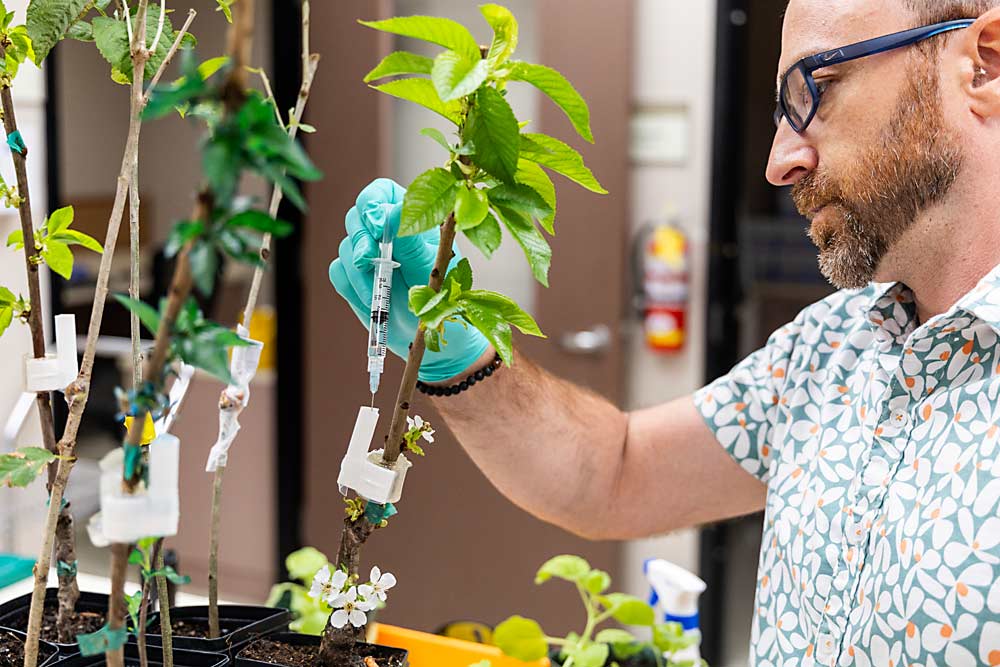
Luigi Catalano - Agrimeca / Civi Italia (IT)
Cherry Times Scientific and Technical Committee
This was the title of a meeting held on 15 March at the operational headquarters of the OP Giuliano - PugliaFruit in Rutigliano (Bari, Italy) where, in the presence of fruit growers and sector technicians, the problems of a sector that shows alarming signs of little interest and disaffection on the part of farmers were discussed. The meeting was also attended by the first citizens of Casamassima, Conversano, Sammichele di Bari and Turi, all cherry-growing municipalities in the south-east of Bari.
The climate of mistrust among operators can be seen in the hundreds of hectares uprooted in recent seasons, the abandonment due to old age of large areas planted with varieties that marked regional cherry growing a few decades ago - Bigarreau Moreau, Giorgia, Ferrovia, etc. - and the abandonment of the varieties that were the mainstay of the regional cherry industry.
In addition, there is also the lack of renewal with the planting of new varieties with the characteristics required by the market, the increasing difficulty in effectively protecting production from the advent of new harmful organisms, and finally the lack of manpower and cumbersome recruitment procedures.
A complex picture with old and new criticalities, which, however, if analysed well, shows the possibility of valid solutions to overcome them successfully. This is what emerged during the meeting, which saw the testimony of numerous convinced but defenceless cerasiculturists in the face of new phytosanitary emergencies - above all the red fruit fly Drosophila suzukii - who are demanding the availability of new active ingredients to be used for fruit defence.
Agostino Santomauro and Gianvito Ragone of the Apulia Region's Phytosanitary Service illustrated the new features of the soon-to-be-published integrated pest management regulations and the actions implemented to control drosophila.
In fact, Apulia is among the regions that have joined the national plan to control the insect through the launch of the endoparasitoid larval hymenoptera Ganaspis brasiliensis. The parasitoid is bred at the laboratories on the campus of the Mediterranean Agronomic Institute in Valenzano and will soon be released in fields in the south-east of Bari.
A correct approach to integrated pest management was reaffirmed, which is not limited to the mere distribution of agrochemicals, but includes all agronomic aspects - soil management, canopy management, nutrition, etc. - for a correct crop balance. The possibilities for active pest management with respect to 2023 are outlined below.
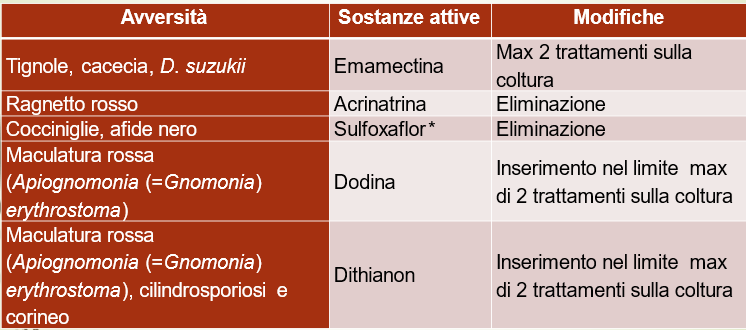 *approved emergency use from 1/3/2024 to 28/6/2024.
*approved emergency use from 1/3/2024 to 28/6/2024.
Other novelties concern the functional control and instrumental adjustment of spray equipment, which must be carried out at accredited and recognised test centres.
In fact, machines in use must have a valid certificate of functional control and instrumental adjustment (3 years). In the absence of instrumental adjustment, a new functional control and instrumental adjustment certificate is required within the year of joining SQNPI (Sistema di qualità nazionale protezione integrata - National Quality System for Integrated Protection) regardless of the validity of the functional control certificate already in place
New machines, on the other hand, must undergo functional control and instrumental adjustment within the year of joining SQNPI or within one year of purchasing the machine (although according to NAP requirements they should undergo functional control within the first 5 years of purchase).
Turning to the technical aspects, Luigi Catalano of Agrimeca Grape & Fruit Consulting outlined the major varietal innovations that may affect the crop in the coming years. He began by emphasising the great attention that the cherry tree is receiving from public and private research around the world, witnessed by the 50 genetic improvement programmes operating on all continents.
This confirms the cherry's rise to the top of consumer attention, no longer relegated to being a minor fruit species. However, the large variety offer risks confusing cherry growers, who are always looking for the 'panacea variety' that will cure all ills. Without experimentation and validation in their own growing environments, it is a risk to focus on varieties that have been evaluated and appreciated elsewhere in different soil and climate conditions.
Two parameters above all to consider: cold requirement and self-fertility. At present, of all the varietal innovation proposed in the last five decades, consolidated data show that the varieties published by the University of Bologna - Grace Star, Black Star, Sweet Aryana, Sweet Gabriel and Sweet Lorenz, with a mention for the low cold requirement variety Royal Tioga - are those that have performed best in Apulian growing environments, with good productive and qualitative performance.
The need to test varietal innovation in local conditions and on the only rootstock - magaleppo (Prunus mahaleb) so far available and guaranteed for Apulian soils was emphasised. These are activities that can be initiated and carried out within the framework of POs. In this regard, the audience was informed that the OP Giuliano - PugliaFruit has started activities to this end, which also involve a rootstock trial to identify valid alternatives to magaleppo.
Lorenzo Laghezza, also from Agrimeca Grape & Fruit Consulting, illustrated the proposal of an innovative breeding form compared to the traditional pot. This is the multi-axis pot, also known as the KGB (Kim Green Bush) system, which makes it possible to create pedestrian groves that are completely manageable from the ground, with an easy design and simple canopy management, as well as an early entry into production.
There are already numerous experiences of planting with this form of cultivation in the different growing areas of Apulia with different varieties and also in covered cultivation. All the varieties grafted onto magaleppo have responded well with full entry into production in the 3rd year in view of the lack of cutting of shoots left to grow to the top, contrary to the situation with the pot training form.
The only caesarean interventions are referred to the early branches along the axis, intervening then with the reduction of the top from the 3-4th year onwards. This form of cultivation lends itself to exploiting, with a few slight modifications, the infrastructure of vineyards trained with a canopy, thus permitting coverage with plastic film and nets.
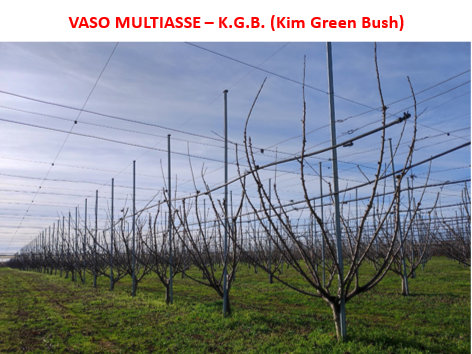
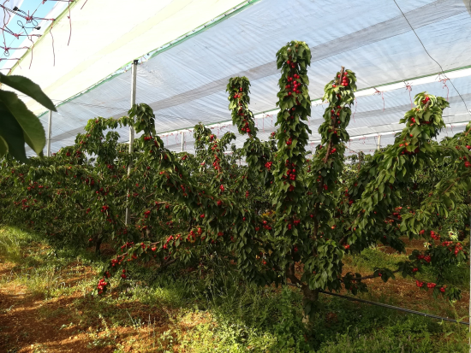
Aspects related to the opportunities provided by the CAP 2023-2027 strategic plan for the fruit-growing sector, including cherries, were illustrated by Giovanni Stampi of STEA srl, who explained all the financial instruments available through
- the rural development plans (RDPs)
- direct payments
- sectoral aids (former CMO)
and the evolution of POs, as last defined by EU Reg. 2021/2115.
In addition to the cross-sectoral interventions for the production chain, which include technical assistance and single- and multi-risk insurance coverage, of considerable interest are the specific interventions that provide contributions to expenses for
- new plants
- protection structures
- cultivation operations
- technical means
- integrated production and defence
- machinery and equipment.
In conclusion, through aggregative forms, it is possible to innovate the entire cerasic chain for its better sustainability and competitiveness.
The moderator of the meeting was Nicola Giuliano, also in the role of 'provocateur', who emphasised the need for a strategic vision of the entire cherry sector production chain, facilitated by the popularity of Made in Italy products. Planning and innovation are the watchwords, to launch actions and initiatives that first and foremost provide the security of being able to harvest a quality product, without the constant risk of atmospheric calamities or damage caused by pests and pathogens.
In fact, it is necessary to assure retailers and markets of constant flows of product throughout the season, without the risk of supply shortages. This is how the Anglo-Saxon market has been compromised: before the last disastrous years due to bad weather during the harvest period and drosophila, 50 trucks per day left Rutigliano, which hosts important packing houses with a high specialisation in cherry trees, for the UK, as opposed to the last few seasons which have seen no departures at all!
Another topic touched on by Giuliano is that of the rules regulating the production of fruit - not only cherries in third countries, where means of production not allowed in the EU are allowed. This ends up fuelling inequality to the detriment of local and national producers who have their weapons blunted against old (cherry fly) and new (drosophila) phytosanitary emergencies.
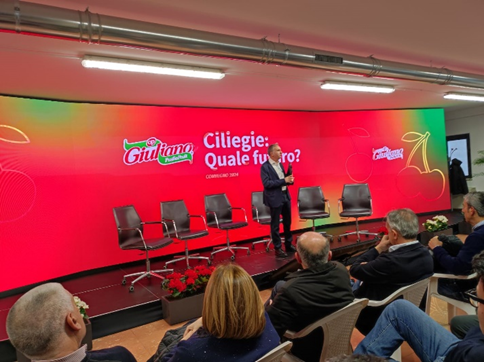
The watchword must be to innovate plants to enable production to be guaranteed with sustainable solutions, aiming for maximum efficiency, in the knowledge that initial investments in technology and infrastructure can make the sector more competitive. This process is already underway in some areas in northern Italy: in Trentino, Veneto and Emilia-Romagna regions.
This must take place within a programmatic framework, through regional and national planning.
If, on the one hand, the Region, which is responsible for local development policies with the RDPs, must envisage initiatives to modernise the sector, on the other hand, at the national level the Ministry in charge must take action for a concrete plan to relaunch the made-in-Italy cherry, intervening rapidly - for example - with the signing of international agreements that overcome the current phytosanitary barriers and allow the export of national production to more remunerative markets.
Summarising what emerged during the meeting, which was attended by over 200 participants, on the producers' side the expectations are for:
- New varieties and systems to anticipate ripening
- Public support to encourage the creation of suitable protection structures for cherry orchards
- More effective active ingredients for protection against newly introduced and more aggressive pests as a result of climate change
- Simplifications for the procurement of agricultural labour, with bureaucratics procedures
Traders, who are the link between the market and consumers wish:
- to be able to start the marketing year earlier in order to command better prices, thanks to production in covered facilities and the authorisation to use dormancy switches
- the availability of varieties with high organoleptic values, crispness, resistance to handling and long shelf life
- total phytosanitary safety of the fruit, so that companies can join qualification and certification systems (e.g. Global Gap)
- a correct harvesting of the fruit, without damage that is then highlighted by sophisticated sorting and grading systems: it is from this moment that the success of the sale of the fruit in supermarkets is decided
- a continuity of product throughout the season thanks to cultivation in protected structures, as is now consolidated with table grapes.
Concluding, Nicola Giuliano stated that by partially resolving the criticalities indicated and reducing the risks outlined above, thanks also to the goodness that is recognised and reserved for Made in Italy cherries, the future of regional and national cherry farming can still play a leading role.
Luigi Catalano & Lorenzo Laghezza
Agrimeca Grape & Fruit Consulting srl
Cherry Times - All rights reserved









